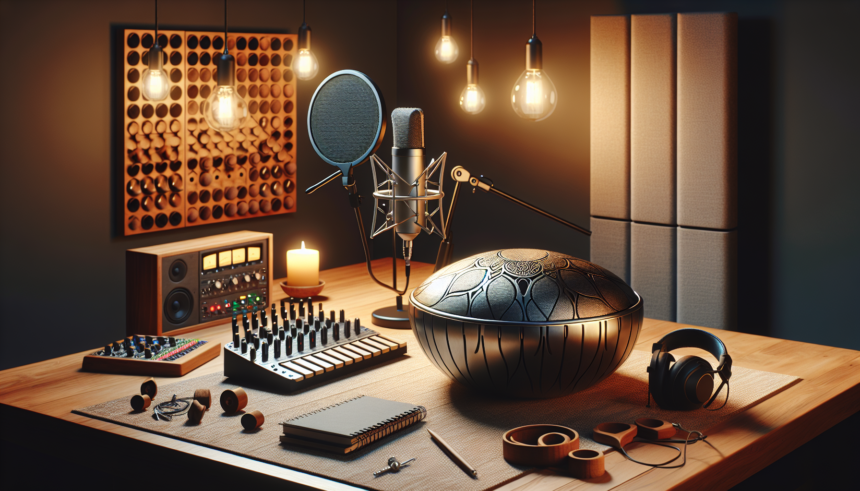Introduction
The handpan is a mesmerizing and unique musical instrument with a distinct sound that captivates listeners. Achieving studio-quality recordings of your handpan can be a challenging yet rewarding process. Whether you’re a seasoned musician or a beginner, the right techniques, equipment, and environment are critical to capturing the full essence of your handpan’s sound. This article will guide you through essential steps to recording your handpan with studio-quality results.
Select the Right Equipment
High-quality recordings start with the right equipment. Below are the essential components you’ll need:
Microphones
Selecting the right microphone is crucial for capturing the intricate details of your handpan. Condenser microphones are generally preferred due to their sensitivity and frequency response. Here are some options:
- Neumann KM 184: A popular choice among professionals for its clear and natural sound.
- Audio-Technica AT4053b: Known for its detailed sound capture and versatility.
- Rode NT5: Budget-friendly option that still offers excellent quality.
Audio Interface
An audio interface acts as a bridge between your microphone and computer. Look for one with clean preamps and low noise levels. Popular choices include:
- Focusrite Scarlett 2i2: Widely used for its reliability and affordability.
- Universal Audio Apollo Twin: Offers high-quality preamps and built-in effects.
Headphones
Invest in a good pair of studio headphones for accurate monitoring. A few recommendations are:
- Audio-Technica ATH-M50x: Known for its balanced and detailed sound.
- Beyerdynamic DT 770 Pro: Offers excellent comfort and sound quality.
DAW (Digital Audio Workstation)
Your DAW is the software you’ll use to record and edit your handpan tracks. Popular options include:
- Logic Pro X: A comprehensive DAW suitable for both beginners and professionals.
- Ableton Live: Known for its intuitive interface and powerful features.
- Pro Tools: Widely used in professional studios for its advanced editing capabilities.
Prepare Your Recording Space
Creating a suitable recording environment is essential for achieving studio-quality sound. Here are some tips:
Acoustic Treatment
Minimize unwanted reflections and noise in your recording space by using acoustic panels, bass traps, and diffusers. These help to create a balanced acoustic environment, allowing your handpan’s true sound to shine through.
Sound Isolation
Ensure your recording space is free from external noise. If possible, choose a quiet room away from street noise, household appliances, and other disturbances. Use soundproof curtains or isolation booths if needed.
Ambient Noise Management
Turn off any sources of noise, such as fans, air conditioners, or computers, before recording. Even subtle sounds can be picked up by sensitive microphones, affecting the quality of your recordings.
Microphone Placement Techniques
Proper microphone placement is key to capturing the nuances of your handpan. Experiment with different techniques to find the best sound:
Close Miking
Position the microphone about 6-12 inches away from the handpan. This technique captures the direct sound and minimizes room reflections. Angle the microphone towards the center of the handpan for a balanced capture.
Overhead Miking
Place the microphone above the handpan, about one to two feet away, pointing downwards. This technique captures a more natural and ambient sound, taking in the resonance and decay of the notes.
Stereo Recording
Use two microphones to create a stereo image of your handpan. Common stereo techniques include:
- XY Technique: Cross two microphones at a 90-degree angle for a balanced stereo image.
- ORTF Technique: Place two microphones 17 cm apart at a 110-degree angle for a wider stereo field.
Setting Up Your Recording
Once you have your equipment and space prepared, it’s time to set up your recording session:
Gain Staging
Proper gain staging ensures a clean and distortion-free recording. Adjust the input gain on your audio interface so that the signal peaks around -6dB to -3dB.
Mic Check
Before recording, perform a mic check to ensure optimal sound quality. Play your handpan and listen through your headphones, making any necessary adjustments to microphone placement or gain settings.
Recording Techniques
When recording, focus on consistency and precision. Play at a steady tempo and avoid abrupt volume changes. Consider recording multiple takes to capture the best performance.
Editing and Mixing
After recording, the next step is to edit and mix your tracks to enhance the overall sound:
Cleaning Up the Recording
Remove any unwanted noise or mistakes using your DAW’s editing tools. Trim the beginning and end of your recordings, and use crossfades to create smooth transitions between takes.
EQ (Equalization)
Use EQ to balance the frequencies of your handpan recordings. Cut any unnecessary low frequencies (below 100 Hz) to remove rumble, and make gentle boosts in the mid and high frequencies to enhance clarity and presence.
Compression
Apply compression to control dynamics and add consistency to your recordings. Set a modest threshold and ratio to smooth out any loud peaks while maintaining the natural dynamics of your handpan.
Reverb
Reverb can add depth and space to your recordings. Use a subtle reverb to enhance the natural resonance of your handpan, creating a sense of ambiance without overwhelming the sound.
Final Touches
Once your tracks are edited and mixed, apply the final touches to achieve a polished, professional sound:
Mastering
Mastering is the final step in the production process. It involves fine-tuning the overall sound of your recordings to ensure they sound great on various playback systems. Use mastering plugins or consider hiring a professional mastering engineer for the best results.
Proof Listening
Listen to your mastered recordings on different playback systems, such as studio monitors, headphones, and car speakers. Make any necessary adjustments to ensure your recordings sound balanced and clear on all systems.
Exporting
Export your final recordings in a high-quality format, such as WAV or FLAC, to preserve the audio quality. Consider creating multiple versions (e.g., MP3 for online sharing) depending on your needs.
Conclusion
Achieving studio-quality recordings of your handpan requires careful planning, the right equipment, and attention to detail. By selecting high-quality microphones, preparing your recording space, and mastering essential recording and editing techniques, you can capture the rich, resonant sound of your handpan. With practice and experimentation, you’ll be able to produce stunning recordings that truly showcase the beauty of this unique instrument.
FAQs
-
What type of microphone is best for recording a handpan?
Condenser microphones are generally preferred for their sensitivity and accurate frequency response. Popular models include Neumann KM 184, Audio-Technica AT4053b, and Rode NT5.
-
How should I place the microphone when recording a handpan?
Experiment with close miking, overhead miking, and stereo techniques. Close miking captures direct sound, while overhead miking captures a more natural ambiance. Stereo techniques like XY and ORTF can create a wider sound image.
-
What audio interface should I use for handpan recording?
Choose an audio interface with clean preamps and low noise levels. Popular options include Focusrite Scarlett 2i2 and Universal Audio Apollo Twin.
-
How do I reduce ambient noise during recording?
Turn off any noise sources in your recording space, use soundproof curtains or isolation booths, and choose a quiet room away from external noise.
-
What is the role of EQ and compression in mixing handpan recordings?
EQ balances the frequencies by cutting unnecessary lows and boosting mids and highs for clarity. Compression controls dynamics, smoothing out peaks while maintaining natural sound.





